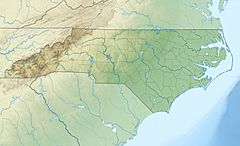Bear Creek (Neuse River tributary) facts for kids
| Other name(s) | Bear Creek |
|---|---|
| Country | United States |
| State | North Carolina |
| Counties | Wayne, Lenoir |
Quick facts for kids Physical characteristics |
|
| Main source | Bear Creek W/S Lake #3 35°24′51″N 77°52′47″W / 35.414082°N 77.879703°W |
| River mouth | 35°13′56″N 77°46′43″W / 35.232176°N 77.778741°W |
| Basin features | |
| River system | Neuse River |
Bear Creek is a stream in North Carolina, USA. It flows into the Neuse River, which is a much bigger river. The land around Bear Creek is mostly used for farming. Because of this, the water in the creek has a lot of nitrates, which can be a type of pollution.
Contents
Where is Bear Creek Located?
Bear Creek flows into the Neuse River, which is North Carolina's longest river (about 275 miles long!). Bear Creek starts in eastern Wayne County, North Carolina. Small lakes and ponds, like Bear Creek W/S Lake Number Three, feed its beginning.
Bear Creek's Path
The creek flows southeast, forming a border between Wayne and Greene counties. Then it enters Lenoir County before joining the Neuse River. You can see Bear Creek flow under U.S. Route 70 between the cities of Goldsboro and Kinston.
History of the Creek
People have known about Bear Creek for a long time. It was first mentioned in local records way back in 1742. Originally, the area around the creek was a swampy wetland. In the early 1900s, canals were built to drain the swamp. This made it possible for farmers to use the land for crops.
Land Use Around Bear Creek
Today, the land around Bear Creek is mostly used for farming. This includes growing crops and raising many animals on large farms. About 67% of the land in the area is used for agriculture. Forests cover about 25%, and water or wetlands make up 5%. Only a small part, about 3%, is urban or city land. The creek mainly gets its water from underground sources.
Efforts to Restore Bear Creek
Bear Creek gets a lot of nitrates from the farms nearby. Nitrates are chemicals often found in fertilizers and animal waste. When it rains, these chemicals can wash into the creek. This can cause pollution and harm the creek's natural environment.
How Pollution Enters the Creek
Farmers sometimes use special underground pipes called tile drains. These drains help move water away from fields quickly. However, they can also carry nitrates directly into the creek. Scientists studied Bear Creek from 2002 to 2003 to understand how much nitrate pollution was present.
Bringing the Creek Back to Life
To help clean up Bear Creek, people started a big project. In an area called the Bear Creek-Sleepy Creek Core Restoration Area, they worked to bring the creek back to its natural state. They filled in more than 3 miles of old drainage canals. Large dirt walls that held back water were removed. In their place, smaller, more natural structures were built to help the water stay in the area longer. In 2001, almost 50,000 young trees were planted in the restored area. These efforts help the creek become healthier and more like it was naturally.


